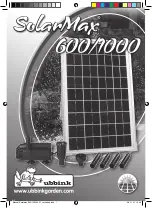
3
Chapter 1: Introduction
WARNING:
Wiring work should be performed according to the provisions of the National Electrical
Code . Grounding work and wiring connections to the inverter should be performed by a qualified
electrician .
Please adhere to all applicable codes, required permits, and regulations concerning the installation and
inspection requirements as they pertain to your location . Pay special attention to Article 110, Chapter 2
Article 250, Chapter 3, Articles 300, 310, 480, and 690 .
WARNING:
The solar array generates electricity whenever it is exposed to sunlight . Be careful when
handling it . There is a danger of shock if you touch the connectors or wires of the electric cables .
Points to Check Before Wiring
• The solar modules generate electricity when exposed to light . You will need to wear insulating gloves .
• You will need a multimeter for volts, amps, resistance, and continuity capable of measuring DC and AC
up to 600V and 40A .
• Make sure your tools are insulated .
Wiring Solar Panels
• Never step or sit on the glass surface of the solar modules . The glass may break .
• When you install the solar modules on the mount, never allow an output cable to become caught
between the mount and a module frame .
• Ensure that the module connectors are fully inserted . There is a risk of malfunction if they are not
pushed all the way in .
• Support output cables to eliminate slack . High winds can blow slack cable against the mount, damaging
the cables .
Wiring Solar Arrays to the Inverter
• For wiring through walls, protect the cables with metal conduits, flexible metal conduits as permitted or
required by local and national electrical or building codes . Failure to do so can result in shock and short
circuits . Always use conduit to protect sections of array output cables that are exposed to sunlight .
• For wiring outdoors, protect cables with PVC conduits, metal conduits, or flexible conduits .
• Prevent water from entering or building up in conduit by using waterproof fittings or duct seal .
• To prevent shock, tape and label the cut ends of array output extension cables (the side opposite to
the connector side) before connecting to solar module output cables . Then, tape them again after
measuring the voltage of each array .
• To prevent shock when you connect the array output cables to the inverter, remove the tape one cable
at a time as you connect the cables .
Measuring Output Voltage
• Ensure that all solar modules are exposed to sunlight . (Remove lightproof sheets, if present .)
• Set the voltmeter measurement range to a DC voltage greater than -32VDC .
• Keep the plus (+) solar array output cables away from the ends of the minus (-) cables, as dangerous arcs
can occur . The array output voltage under normal conditions (clear skies) can be very high .
Grounding the Mount
• Use a proper ground wire according to your local safety regulations and requirements . For more
information, refer to
in this User Guide .
• Follow NEC 690 grounding provisions .
Summary of Contents for sunMAX
Page 1: ...USER GUIDE...
Page 2: ......
Page 6: ...iv sunMAX Solar User Guide...
Page 62: ...56 sunMAX Solar User Guide...










































